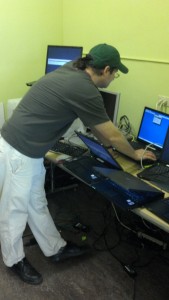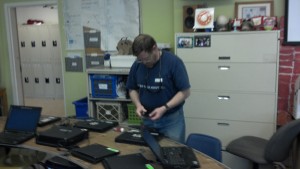On April 28th, the Partimus crew of James Howard, Morgan Wilson and Christian Einfeldt worked to take laptops that James had prepped for installation and finished imaging the systems with the provisioning server. All the laptops were then put together with their power supplies on cart. By the end of the day between already installed laptops and newly installed ones approximately 38 laptops were ready for the classroom!
James has provided the following “big picture” overview of the work completed:
The project we’re wrapping up today is perfectly representative of most of the school deployment projects we’ve done. A project begins with request from an educator for computing capabilities. Once it’s determined that suitable hardware is available or can be procured, we work with the teacher to determine software requirements. This process yields a list of software packages we’ll include in addition to the distribution base install. We also try to develop an approach to how the system will be administered, which users should be created and with which authorization. Lastly, we try to incorporate desktop tweaks to suit the preferences of the particular client. All of this information is translated into a post installation shell script. This script, along with other installer-specific declarations are hosted on a local installation server which also contains a full, up-to-date mirror of a particular Linux distribution’s software repository (usually Ubuntu). Our automated installs are currently exclusively network based, but much of the hardware we work with will only bootstrap by CDROM, so we usually master custom media for boot strapping the installer. Once we’ve worked out the install design and all the hardware kinks, we do some test deployments and conduct a little QA with our educator. Once design is finalized, we go to production. It’s really cool seeing dozens of machines churn through an unattended install in unison.
For this project we decided to go with Lubuntu 12.04 LTS to squeeze maximum performance out of these notebooks. Many of these notebooks will be used by the students to give multimedia presentations, and what’s really exciting is that some of these higher spec machines will be used for video production as they are loaded with about a dozen of the best video production tools available from around the globe.
Speaking of the specific tasks completed that day, Morgan writes:
When I arrived, I got to work assisting James with staging and loading about a dozen laptops with Linux. James already had a couple of CDs with the applicable configuration, so it was simply an assembly-line task of connecting power and network cables to two laptops at a time, and then launching the installation. Once they were running, two more laptops could be connected and launched.
There was one laptop that would not read a CD. In order to further pinpoint the cause, I swapped the CD drives between the bad boy and a known working lap. The CD drive worked in the other lap, and the bad boy continued to fail. This proved that the problem was elsewhere within the laptop. We marked the laptop bad, and saved the CD drive and memory cards for spare parts.
Then I moved on to bundling and labeling laptops and power supplies. By the end of my two and a half hours, I think we had labeled and bundled almost thirty laptops.
The highlight of the day was the two slices of broccoli-pineapple pizza that I inhaled with gusto. This was a flavor combination that I had never heard of before. Weirdly excellent.
Thank you again for the opportunity to pedal my wares.
Special thanks to CACS parent Robbie Socks for procuring the donated notebooks from Lycée Français de San Francisco and thanks again to the crew for joining us in this event!



Post a Comment